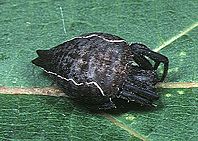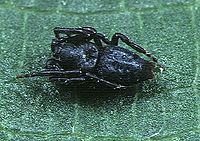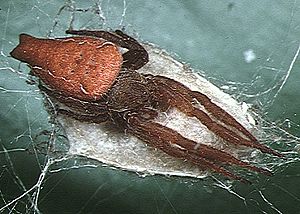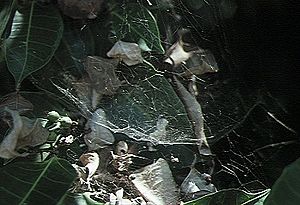Double-tailed tent spider facts for kids
Quick facts for kids Double-tailed tent spider |
|
|---|---|
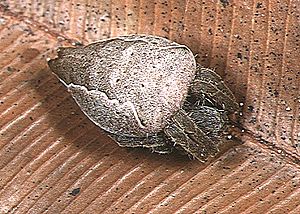 |
|
| Female Cyrtophora exanthematica | |
| Scientific classification | |
| Genus: |
Cyrtophora
|
| Species: |
exanthematica
|
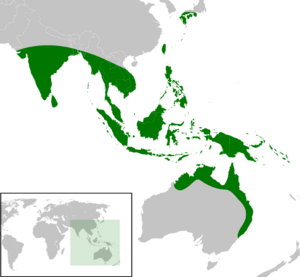 |
|
| C. exanthematica distribution map | |
| Synonyms | |
|
|
The Cyrtophora exanthematica is a type of tent spider. You can find them in warm, tropical parts of Asia and Australia. People often call them double-tailed tent spiders. This is because they have two small, blunt bumps at the end of their bodies. Don't worry, these spiders are completely harmless to humans!
Double-tailed tent spiders create big webs that are not sticky. Their webs have two main parts. One part is a messy, tangled web. The other is a flat, finely woven web that looks like a bowl. Female spiders are much bigger than males. They can also be many different colors. You can easily tell them apart by their body shape and the patterns on their backs. Females also protect their eggs by spreading their bodies over them.
Contents
What Does the Double-tailed Tent Spider Look Like?
The name 'double-tailed tent spider' comes from the two blunt bumps on their abdomen (their back body part). In Australia, they have other names too. These include 'dome spider', 'bowl spider', 'pan-web spider', and 'scoop-web spider'.
Spider Body Parts
Like other Cyrtophora spiders, their cephalothorax (the front part of their body where their head and legs are) is flat on top. White hairs cover their cephalothorax, the sides of their abdomen, and their legs. They have eight eyes, all about the same size. These eyes are set in two curved rows.
They also have two bumps on the front of their abdomen. These bumps look a bit like 'shoulders'. They give the spider a special triangular shape. On the top of their abdomen, there are eight small, noticeable pits called sigilla. These are arranged in two rows. The abdomen is somewhat rectangular with flat sides. It has small bumps at the front. It is longer than it is wide and gets narrower towards the back. The underside of the abdomen is usually brown. Their book lungs (breathing organs) are yellow. The spinnerets (silk-spinning organs) have white edges.
Colors and Sizes
These spiders can be many different colors. They might be red, pink, orange, yellow, brown, grey, light brown, or even completely black. Some spiders have two wavy, chalk-white lines on their abdomen. These lines run from the front of the abdomen to the 'shoulder' bumps and down to the 'tails'. In other spiders, these lines are very faint.
Male and female double-tailed tent spiders are very different in size. This is called sexual dimorphism. Males are much smaller than females. Adult females are usually about 10 mm (0.4 inches) long. But they can grow up to 15 mm (0.6 inches). Adult males are only about 3.5 to 6 mm (0.14 to 0.24 inches) long. Their abdomen is about the same size as their cephalothorax.
The double-tailed tent spider looks a lot like Cyrtophora parangexanthematica from the Philippines. Its scientific name even means "like exanthematica" in Filipino.
Spider Families and Names
The double-tailed tent spider was first described in 1859. A Slovakian military surgeon named Carl Ludwig Doleschall found it while in Java. He first put it in a group called Epeira. This group is now known as Araneus.
Today, these spiders are part of the genus Cyrtophora. This group is also known as tent-web spiders. They belong to the very large orb-weaver spider family, called Araneidae.
The name Cyrtophora means "curve bearer" in Greek. This refers to the curved shape of the abdomen of these spiders. The specific name "exanthematica" also comes from Greek. It means 'pimple' or 'pertaining to a pimple'. This name refers to the spider's appearance.
How Do They Build Their Homes?
Double-tailed tent spiders usually build their webs in trees or bushes. They use nearby leaves and twigs to help build the web's frame. The webs have two clear parts. The top part is a messy, thick tangle of supporting webs. This 'tangle web' helps stop prey from entering the web from above.
Below this is a flat, very finely woven web. This 'orb web' is about 0.5 meters (1.6 feet) wide. Like other tent-web spiders, this web is somewhat tent-shaped. But the orb webs of double-tailed tent spiders often look more like a pan or a bowl. No part of their web is sticky. This is different from the webs of many other orb-weavers.
The spider usually stays in the middle of the lower orb web, hanging upside down. If it feels in danger, it will run to the edge of the web. There, it hides among the leaves and bits of nature. The spider has a safe spot at the edge of its web. This spot is surrounded by dead leaves, which help it blend in. Sometimes, a male spider might live in the same web as a female.
These webs are permanent homes. Over time, leaves and other bits of debris will collect in them. Double-tailed tent spiders clean their webs regularly, usually at night. But they do keep some small pieces of debris for camouflage. If the web gets badly damaged, they sometimes have to rebuild it.
Raising Spiderlings
Double-tailed tent spiders mate during the summer. After mating, the female lays her eggs in an egg sac. This sac is an oval ball made of spider silk. She places it in her safe spot. Then, she stretches her body over the egg sac and guards it. This behavior is special and makes the species easy to recognize.
The mother spider does not eat or leave her safe spot until the eggs hatch. This usually takes two or three weeks. After the eggs hatch, she returns to the center of the web. The baby spiders, called spiderlings, stay in her safe spot for a few more weeks. Then, they leave to find their own homes.
Uninvited Guests
Because their webs are quite large, they often have tiny, uninvited guests. These are called kleptoparasitic split-faced silver spiders (Argyrodes fissifrons). These 'dewdrop spiders' can build their own webs. But they prefer to live and even have babies in the webs of other spiders. They steal food from the host spider's web.
Sometimes, this relationship can be helpful for both spiders. The dewdrop spiders eat prey that is too small for the larger double-tailed tent spiders. However, they often help themselves to the host's stored food. They might even take food the host spider is eating! Larger dewdrop spiders are bolder. But they usually stay on the tangle webs and out of the way of their hosts. Double-tailed tent spiders seem to allow them to stay. But they sometimes push them away if they catch larger prey.
Where Do They Live?
Double-tailed tent spiders are found across tropical Asia and Australia. Their natural range goes from Australia up to southern Japan. It also stretches from the Philippines and Papua New Guinea all the way west to India. They usually build their permanent webs on the branches of trees or shrubs.
Spiders and Humans
Like other tent-web spiders, double-tailed tent spiders are very shy. If they feel threatened, they will usually run away. They might also play dead, which is called thanatosis. They are not aggressive towards humans. It is very unlikely they would bite a human unless they were greatly provoked. No bites from these spiders have ever been recorded.
Scientists are also studying the silk of double-tailed tent spiders. They are looking into how it could be used to create tiny capsules called nanocapsules and microcapsules.


